Houses of Merida Video: The Good Life
Click to watch the walkthrough on Vimeo!
Neighbors
When we first moved to Merida in 2002, the house next door to us was empty. We lived in Casa Panadero, and the house next door was called Casa Pocito. We rented Casa Pocito for awhile as an office, but soon moved into our own building a few blocks away. A few months later, new owners moved in and we considered ourselves very fortunate to have such friendly and fun neighbors.
Our new neighbors had retired from their jobs in Charleston, South Carolina, and had moved to Merida to relax. We enjoyed living next to them, sharing our experiences of this new adventure called "moving to Merida"... but most of all, we loved seeing how they decorated their house, which had a floor plan that was a mirror image of ours. They always had colorful art, beautiful flower arrangements, a glass of something cold with ice and of course, they had Max, the regal black standard poodle, who lent an air of elegance to any room he graced with his presence.
Imagine our surprise and dismay, then, when they announced that they had sold Casa Pocito and were going to build a new home in south Merida. They were one of the first gringos we knew who ventured down south of the zocalo (soon to be followed by hundreds of others, including ourselves...). They found a large colonial building that was mostly facade, backed by a huge piece of land. They designed the house they built there for lots of cool shaded space inside, and a big garden to plant and tend in the back. And, of course, room for guests and a swimming pool.
Working with Manuel Kuk, a local contractor, and their own design, they were able to finish the house in about five months for less than $200,000 USD. Even taking into consideration that this was before the costs of materials (especially cement and block) went up a few years ago, this was an impressive accomplishment. They built a very large and luxurious home for a reasonable price in record time.
How did they do it? Well, first, by doing it a few years ago. Also, by being their own architects. And by being there every day, day after day, and making it their top priority. By reusing the rocks they cleared out of the dirt, keeping things simple and being creative with humble materials. Their local contractor, Manuel Kuk, was well known to them, and was pleasant and easy to work with, and his workers were efficient. And the house, while large, is a simple layout, which made for few misunderstandings.
A Great Room
The front part of the house is the original structure, with two guest rooms, one on either side of the wide entryway. The facade sports those old-fashioned windows with the straight old iron protectores that just say "Mexico" and inspire window-envy... until you step inside the foyer, look up and are consumed with old-wooden-beamed-ceiling envy. Such is life in Merida. If you visit other people's houses, be prepared for house envy. It's rampant here.
Everything behind those three front rooms was built new, but by now (four years later), you really can't tell the difference. The central patio with a gurgling stone fountain is reminiscent of the courtyard in the Frida Kahlo movie, minus the peacocks and parrots. While we're on the subject of animals, when we shot this video, the whole house was very obviously minus Max, the stately dog, on our visit, as he just passed away a few weeks before we were there. We missed his presence, but we're happy to see that the owners are looking at this as an opportunity to travel without guilt, which seems like a good way to deal with a sad event.
Moving past the sorrow and the patio, you walk through a screen door into what seems to be the largest room in a private home in Merida. We're here to tell you that it is NOT the largest room in Merida. There are some amazing homes here with cavernous rooms.
When you walk into this house, though, it is almost as if the house flings open its architectural arms in exuberance, inviting you to revel in all the space that it has to offer and you have to enjoy. This coral-colored room is quite large... large enough to hold string quartets and audiences of 100 comfortably. Though unplanned, this room has wonderful acoustics and has been the site of more than a few musical events since it was built. The elegant floor tiles from Mosaicos Peninsular (very Versace-esque!), the white-lined arches that march down each side and the beautiful flower arrangements add to the grandeur that is this Great Room.
The Rest of the Rooms
The main house only has one bedroom... a very large bedroom at the back, facing the garden. The bedroom and the bathroom are set apart from the rest of the house by color... soft swaths of violet and pink cal paint that surprisingly go perfectly with the colonial red zocalo tiles that provide footings to all the walls and with the grey slate tiles in the bathroom. On the same side of the house is an inviting kitchen with a warm Moroccan chandelier that hangs low over an island, and a talavera tile backsplash against the kitchen counter. In the middle on that side of the house is a den with an impressive bookshelf and all the media accoutrements needed in the 21st Century.
On the other side of the Great Room is another big room, running the length of the house and painted in a soft ochre color, where dining and visiting are the main events. The dark wood oversized dining room furniture would probably overwhelm in most homes, but here it looks perfect. And the modern art, including the modern sconces and other works by Katrin Schikora, is a great counterpoint for the mostly traditional furniture. And all the rooms are topped off with very high ceilings, and strategically placed tragaluces (skylights).
A screened-in porch area at the back of the house looks into the garden. Four years ago, the owners planted this garden and the plants have grown so prodigiously that they had to remove trees and other plants to keep from recreating an Amazonian jungle. What we especially love is the formal layout... four quadrants of planting, surrounded by stone walkways, and in the center, a large fountain that adds the sound of water. Each of the four quadrants now has a thriving orchid tree, with its butterfly-shaped leaves and pink orchid-like blooms.
Beyond that, away from the house, is a large swimming pool with plenty of places to sit in the sun, though frankly, we don't do that much here. Sitting in the sun during most of the year is a bit like stepping into a big broiler, so it is important to have ample shade. This garden has shade under an open-air poolhouse with a red-tiled roof, with seating for lounging and dining and enjoying the view.
Life is Good
Life seems good in this house. Everywhere you look, there are beautiful and interesting things. Everything you need is well within reach. There is air and space in this house in good measure... two luxuries that are much appreciated in this climate. By walking around, we can tell that the people who live in this house are enjoying their time here... and besides staying warm and staying out of the rain, isn't that what a house is all about? Here, once again, is La Buena Vida... the Good Life, in Merida!




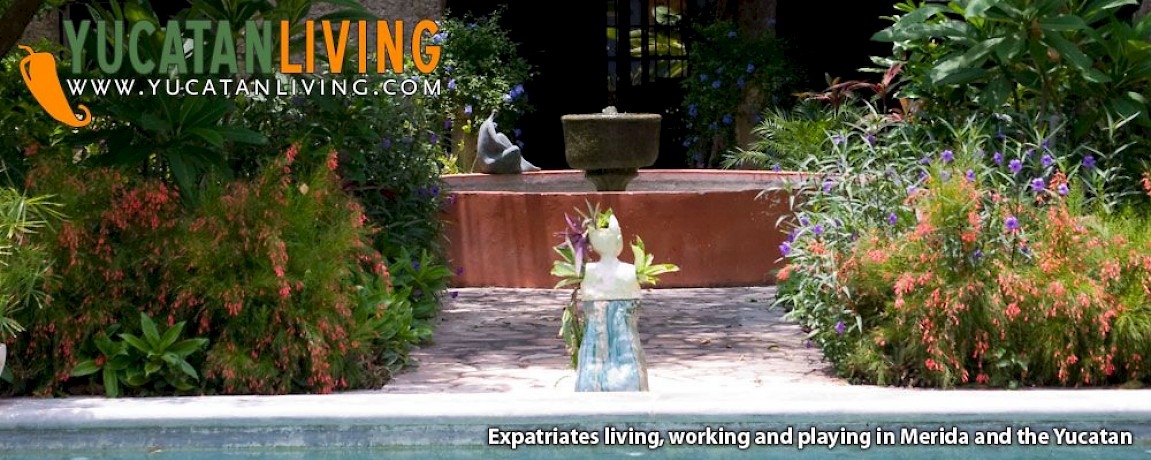


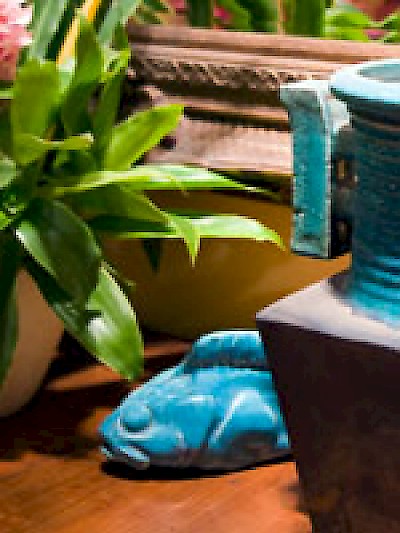
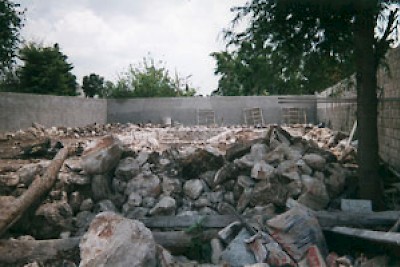
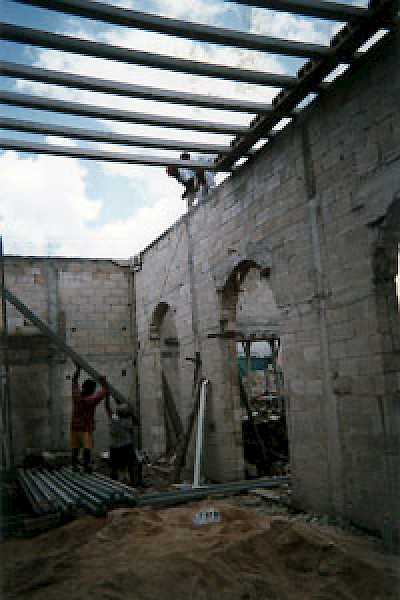
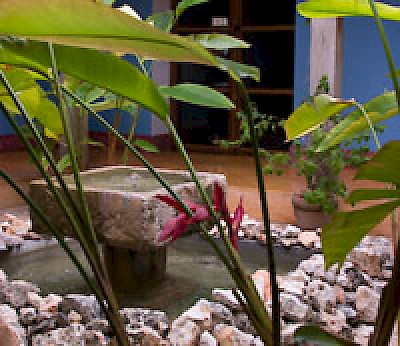

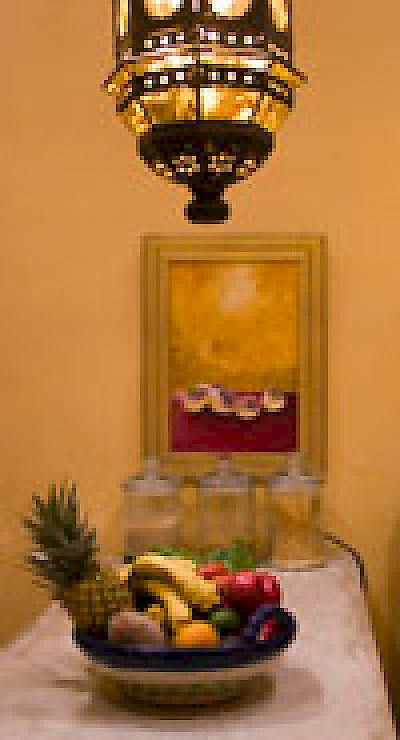
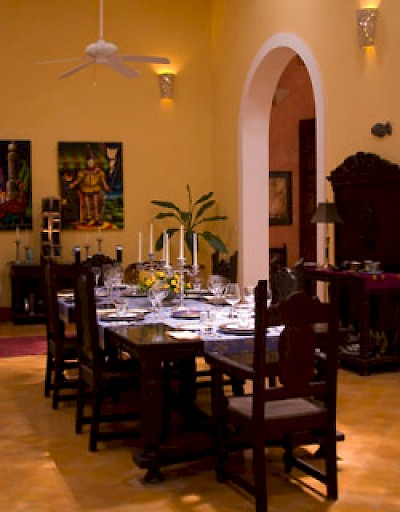

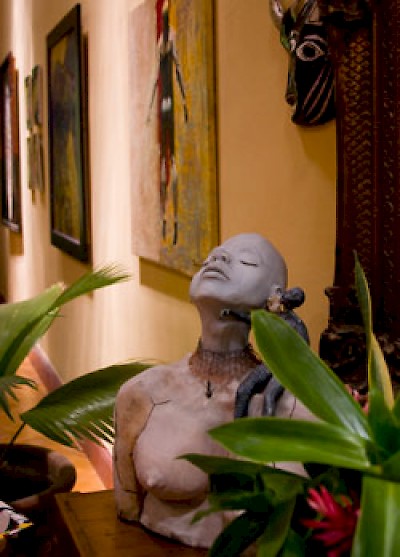

Comments
ALEX BOLANOS 15 years ago
Hello Fabio Fortuna.
I am a mexican citizen that is looking forward to return to his country. I dont have a lot of money but i would like to know how much do you think i would need to buy and remodel a 2 bedroom house in Merida. My family consist of 2 adults and 2 kids and i really like the house that Gregg put a link to. For a house like that (small patio, maybe a pool, 2 or 3 bedrooms, how much im i looking to invest?
my email is alejandrobolanos@hotmail.com i hope you have the time to answer my questions.
Working gringos:
i love the houses if merida segment of your website, thank you for all your beautiful work.
Reply
Gregg 15 years ago
Fabio Im glad you liked the house and understand your position much better. I guess Im a fan of architecture and appreciate both homes while being drawn more to the style of the link. The things you stated are the same reasons we chose to buy and eventually live in Merida. We have to remain focused. This reminds me the discussion where people were upset that the big box stores would ruin Vallodolid. That it would some how ruin its character and charm. While that may be true, unfortunately I dont think we, expats, have too much to say about this since these same stores have homogenized America and in most cases we did little to stop it. (Brooklyn was able to stop a proposed Wal-Mart) Some people dont personalize the business relationship because of their own struggles. 'Ill get it where's its cheapest.' The lure of Western civilization is powerful. However, Im glad we were able to exchange thoughts and ideas.
Reply
fabio fortuna 15 years ago
Gregg: the house you showed through the link is exactly what i mean. It is a smaller home, made absolutely outstanding through small, but efficient choices. Loved it. When it comes to your question about how the 'majority of people ' would live if money was little or no object, I think it is an impossible question to answer, as it is culturally determined. This is a LONG discussion and i do not know if this is the right forum but i try to answer that now: I do not believe that double sinks in a bathroom, stainless steel appliances and walk-in closets the size of a small Central American country are necessities we 'cannot live without'. I believe there are certain 'needs' we think are absolutely necessary that are imposed culturally. Personally, but then again that is 'according' to my own philosophy of living, I believe most people move to Merida to get away from, among other things, a feeling of consumeristic slavery, and to get away from the 'rat race' of Western societies. It is sad to see that a lot of people reproduce exactly what they leave in their own country (including running around selling, buying and remodeling homes as they were supermarket commodities) not realizing that maybe in the tropics you don't need to have enormous storage space for accumulating stuff, and you can actually live lighter and be satisfied. Then again, that is MY personal philosophy and lifestyle. But yes, your link shows a home more in character with my personal feelings of a good remodeling and a creative one.
Reply
lorraine 15 years ago
I am currently in the process of renovating a modest house in La Ermita. When I say modest I really mean it however, it will, hopefully, be perfect for me. I am my own designer and contractor and am learning so much about construction methods here, not to mention increasing my spanish vocabulary! (Merengue is not only a dance) It might be finished by the end of this summer and may be a suitable entry for "Modest Houses of Merida" I am glad, though, that the grande homes are being preserved and protected and I love looking at them despite not wanting to own one.
Reply
Brigitte in NJ 15 years ago
WG, thank you indeed for your clarification about the "centro flooding problem". I have lived in tropical weather and experienced tropical/hurricane rains. The key indeed resides in the quality of the drainage system in place in urban areas. And I am glad to hear that within reasons the city has the upper hand on that.
Reply
Gregg 15 years ago
Wealth and taste are subjective terms that you will never get a definitive determination to what truly defines them. Fabio, the link Im including is, I feel, a modest house. The house was built with sustainable local materials. I curious to see what you think. I'm also curious to know how do you think vast majority of people would live if money was little or no object?
http://www.yucatanliving.com/vacation-rentals/colonial-home-meets-modern.htm
Reply
Working Gringos 15 years ago
Hmmm, we want to comment about the "centro flooding problem". It is true that many years ago, Merida really had a flooding problem. We have read that in the old days, it would rain and the streets would fill up almost instantly, and maybe take days to drain.
After Hurricane Gilberto (which was back in the 1980s), the city took it upon themselves to install drains throughout most of the centro. We lived through Hurricane Isadore, and while there was flooding in the streets, the water did not stand around and a day or two after the rains were over, all of the water was gone.
We are having a good bit of rain in the last few weeks, and during some of those rains, the drainage system gets temporarily overwhelmed, like it does in any tropical city. Some streets are drier than others. And yes, when buying a home, you might consider inquiring what the street is like during the rains. But I daresay there are few if any streets anymore where the water doesn't drain rather quickly. And on streets that do flood, most homes have doorsteps and raised sidewalks to accommodate the water.
Hope that clarifies things...
Reply
Stephen 15 years ago
Thanks Fabio for the clarification and I look forward to seeing your home featured here. I stand corrected on the fairness issue as well, WG.
I wanted to reply to Jennifer Johnson's comment "I hate to see Merida become another San Miguel de Allende..just a playground for spoiled Americans." I own a home in San Miguel as well as in Merida and love both towns. San Miguel has one of the most diverse communities in Mexico. We have people from all over the world living and visiting here. It is one of the most historic towns in Mexico and in every sense a very Mexican community. Yes, there are "spoiled Americans" here (as well as in Merida). However, I disagree with your comment and want to set the record straight. And by the way, I have found living in San Miguel to be no more expensive than Merida with the possible exception of real estate costs. But even where houses are concerned, there are bargains available if a person is patient and willing to wait for "the right house".
Reply
fabio fortuna 15 years ago
First of all to Brenda and Stephen, I have been a fan of this site for years, and the Working Gringos have heard words of appreciation from my side many times. When it comes to the Houses of Merida series, my personal opinion remains, that it is NOT representative of life in Merida, that this is not the way most expats live, let alone Mexicans (and i am not talking about the few rich ones who live in the north and shop at Liverpool or in Europe). Personally i still believe that showing a few haciendas and mansions is not a good way of representing the good life.
I choose to believe that most people move here for the special atmosphere, the culture and the climate and NOT only because they can afford a house ten times cheaper than in Europe or 3 times cheaper than in the USA. I prefer creativity and imagination on a smaller scale, turning a little impossible wreck or ruin into something charming. That is why I LOVED the 'humble house' featured on this series - in other words i believe my criticism to be constructive and NOT destructive.
Reply
Brigitte in NJ 15 years ago
I have become a fan of the series. In every project, I find some inspiration for the house I, one day, intend to renovate. And since I have not yet decided upon Merida or its suroundings, I selfishly suggest the showing of houses by the Beach or from the little villages surounding the city.
And Kevin Cott, thanks for mentioning the Centro flooding problem. I had never heard of it and would not have thought to inquire.
Reply
Working Gringos 15 years ago
After speaking again with the owners, it seems the figure above of $200,000 could use some clarification. This was the estimate that the contractor gave to the owners at the beginning of the project, and this was the amount the owners gave to us when at the start of work we asked them what THEY were paying so we could calculate our own per square meter costs to build the type of house we wanted. Of course as work went along, changes were made in the original plan, such as enlarging the swimming pool, among other things, that resulted in a higher final cost.
If we were to try to reproduce the house now, as we mentioned before, there is also the issue of substantial price increases in materials since that time.
Reply
« Back (10 to 21 comments)Next »